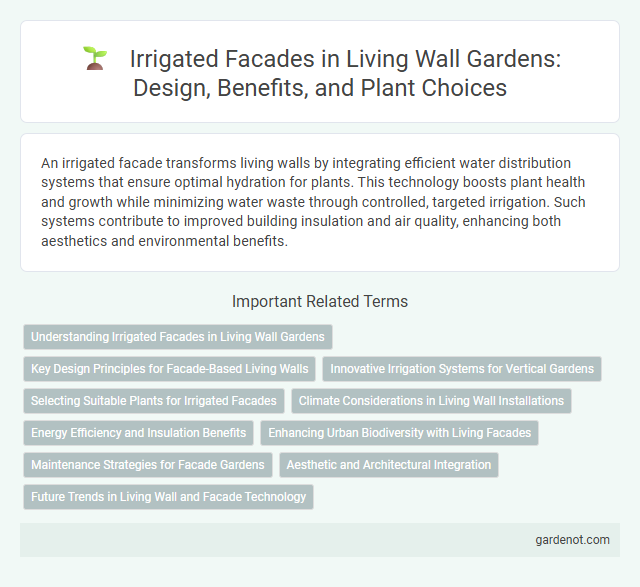An irrigated facade transforms living walls by integrating efficient water distribution systems that ensure optimal hydration for plants. This technology boosts plant health and growth while minimizing water waste through controlled, targeted irrigation. Such systems contribute to improved building insulation and air quality, enhancing both aesthetics and environmental benefits.
Understanding Irrigated Facades in Living Wall Gardens
Irrigated facades in living wall gardens integrate automated drip irrigation systems to ensure consistent moisture delivery directly to plant roots, optimizing growth and minimizing water waste. These facades utilize sensors that monitor soil moisture and environmental conditions, enabling precise water management tailored to specific plant species. Incorporating irrigated facades enhances urban biodiversity, improves air quality, and reduces building heat absorption through efficient hydration of vertical greenery.
Key Design Principles for Facade-Based Living Walls
Irrigated facades in living walls require precise water distribution systems that maintain optimal moisture levels while preventing over-saturation to protect building integrity. Selecting drought-resistant plant species and integrating sensors for real-time monitoring enhance the facade's health and sustainability. Structural components must accommodate irrigation piping and drainage without compromising aesthetic appeal or thermal performance.
Innovative Irrigation Systems for Vertical Gardens
Innovative irrigation systems for vertical gardens enhance water efficiency and plant health by using automated drip and micro-spray technologies integrated within the living wall structure. These systems often incorporate smart sensors to monitor moisture levels and adjust water delivery dynamically, reducing waste and ensuring optimal hydration. Advanced solutions also include recycled greywater usage and solar-powered pumps to promote sustainability in irrigated facades.
Selecting Suitable Plants for Irrigated Facades
Selecting suitable plants for irrigated facades involves considering species that thrive in vertical environments with consistent moisture levels. Drought-tolerant succulents, ferns, and trailing vines like pothos or philodendron perform well due to their adaptability to controlled irrigation systems. Ensuring plant compatibility with the microclimate and facade structure enhances growth, reduces maintenance, and maximizes aesthetic and environmental benefits.
Climate Considerations in Living Wall Installations
Irrigated facades in living wall installations require precise climate considerations, including local humidity levels, temperature fluctuations, and rainfall patterns to optimize water usage and plant health. Selecting drought-resistant species and incorporating smart irrigation systems with sensors can prevent overwatering and reduce water waste in arid or variable climates. Proper shading and wind protection design also enhance microclimate stability, promoting sustainable growth and energy efficiency of the living wall.
Energy Efficiency and Insulation Benefits
An irrigated facade integrated with a living wall significantly enhances a building's energy efficiency by maintaining optimal thermal regulation, reducing heat gain in summer and heat loss in winter. This bioclimatic solution leverages automatic irrigation systems to ensure consistent hydration, promoting dense vegetation that acts as natural insulation, lowering reliance on HVAC systems. Furthermore, the combined effects of evapotranspiration and plant coverage improve indoor air quality while cutting energy consumption by up to 30%.
Enhancing Urban Biodiversity with Living Facades
Irrigated facades create optimal conditions for living walls by providing consistent moisture, essential for nurturing diverse plant species that support urban biodiversity. These vertical ecosystems attract pollinators like bees and butterflies, contributing to ecological balance in city environments. Integrating automated irrigation systems ensures sustainable water use while promoting resilient green habitats on building exteriors.
Maintenance Strategies for Facade Gardens
Irrigated facades require precise maintenance strategies involving regular inspection of irrigation systems to prevent blockages and ensure uniform water distribution across facade gardens. Automated monitoring technology can optimize water usage by detecting leaks and maintaining appropriate moisture levels, promoting healthy plant growth and reducing resource waste. Seasonal pruning combined with nutrient management supports long-term sustainability and aesthetic appeal of irrigated living walls.
Aesthetic and Architectural Integration
Irrigated facades enhance aesthetic appeal by seamlessly integrating lush vegetation with modern architectural designs, creating dynamic vertical gardens that evolve with the seasons. Advanced irrigation systems ensure uniform water distribution, promoting healthy plant growth and vibrant greenery that contributes to the building's biophilic ambiance. This fusion of natural elements and structural innovation elevates facades into living artworks, improving urban aesthetics while supporting environmental sustainability.
Future Trends in Living Wall and Facade Technology
Irrigated facades are advancing with smart irrigation systems that utilize IoT sensors to optimize water usage and monitor plant health in real-time. Future trends in living wall technology emphasize sustainable, energy-efficient designs that integrate renewable energy sources and adaptive materials to enhance urban biodiversity and reduce building energy consumption. Innovations in automated maintenance and AI-driven environmental control systems are set to revolutionize living facades, promoting resilience in diverse climates.
Irrigated façade Infographic

 gardenot.com
gardenot.com